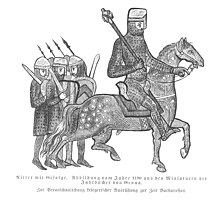entourage
Retinue or retinue refers to a group of henchmen gathered around a leader.
The entourage of a ruler , prince or high noblewoman generally refers to the members of his court who can perform both civil and military tasks.
Fellowship refers to the followers of a leader, party , group or religious community in a general, non-military sense . Military allegiance means, in particular, a clientele-like system of combat cooperatives among the Germanic peoples handed down from antiquity .
history
term
The term allegiance is a new formation of the historical legal and constitutional theory of the 18th and 19th centuries and was first used to translate the Latin term comitatus , which was known from the Germania of Tacitus (Chapters 13 and 14). In the narrower sense of the Germanic tribes, it was understood as a voluntary union of tried and tested men and young men capable of military service around a charismatic or famous leader, usually a king , prince or duke , established by an oath of loyalty . The Lombards used the term servants for this.
Beginnings and sources
The beginnings of the following can be reconstructed from the reports of Caesar in the Gallic War . The "following" or following of a Germanic prince is a temporary association of young, noble men who are bound to the leader through a kind of loyalty relationship exclusively for war purposes. The detailed description in Tacitus differs from this in that the time limit does not apply to him and the men bound by an oath to the prince live in their master's household even after the military ventures have ended. Joining a following conferred honor and prestige ( dignitas ) on followers ; conversely, the number of followers increased the Fuhrer's reputation. The basic requirement for the formation of a following was the war fame of the leader, but presumably also his noble origins and a sufficient material basis to support his supporters.
The followers received free maintenance, personal equipment, a share of the booty and other gifts for their services. In battle they fought vigorously under the employer. They also accompanied their master to the thing . The followers and their people formed a well-armed, always combat-ready elite within the group of free armed forces . In times of peace, the followers also went into armed conflicts with other princes. In the fight against the Romans in the 4th century, it was mainly the Alemannic kings who relied on followers. The mostly limited size of the followers was often overestimated in historical reports, as the followers were confused or mixed up with the warriors who went along voluntarily. The following of the Alemannic juggler Chnodomar numbered around 300 men, while princes such as Ariovistus led several thousand volunteer warriors to armed ventures.
Further development in the Middle Ages
During the time of the mass migration and the settling down of the population, individual functions within the allegiance system developed more sharply and diversified. Especially the appearance at the thing meeting led to a relocation of functions; Thus the buccellari , actually professional warriors of a bodyguard for the protection of private individuals, became a group of auxiliaries, judges and finally bailiffs who carried the seal of the employer until the 7th century in the Visigoth Empire . The buccellari were mainly Germanic tribes in the late Roman period, since the Visigothic allegiance system itself was probably of Germanic origin, but influences of the Roman clientele system cannot be ruled out. In the Longobard Empire , the gasindii , who could be free or freed , formed a social class that was separated from the rest of the warriors and had a special social prestige due to their proximity to the king or duke. The Anglo-Saxon gesiþ also referred to a follower whose social position was below the cyninges þegn ( follower of the cyning ) and above the ceorl (English churl , "guy", free man).
In the Frankish empire only the king had the right to keep followers as so-called antrustiones . In the Merovingian period they were replaced by vassals or fiefdoms , which originally comprised lower servants, but were refined after the model of the allegiance. However, equating a follower and a vassal is problematic, as the Franconian vassalage, despite many overlaps, was only partially linked to the allegiance pattern and was strongly characterized from the beginning by the characteristics of servitude and subordination taken from the area of the household. A continuity of the allegiance system up to the High Middle Ages is sometimes assumed for the Nordic countries , where, despite continental and Anglo-Saxon influences, feudal structures did not prevail until late .
poetry
In the on Germanic tradition going back sagas , from Beowulf on the Round Table of Arthurian legend through to the Nibelungenlied , the following being glorified even at a time when it was long gone from the real life.
suite
In modern times , until the 20th century, the French term suite was used to summarize the military retinue of the sovereign , a general or a commanding general . She accompanied him in his service and could be used by him at will. The suite included the adjutant general , the general staff and orderly officers . They then stood à la suite of the personality concerned.
literature
- Gabriele von Olberg-Haverkate: Followers . In: Lexicon of the Middle Ages (LexMA). Volume 4, Artemis & Winkler, Munich / Zurich 1989, ISBN 3-7608-8904-2 , Sp. 1171 f.
- Christoph Landolt , Heiko Steuer , Dieter Timpe : Followers. In: Reallexikon der Germanischen Altertumskunde (RGA). 2nd Edition. Volume 10, Walter de Gruyter, Berlin / New York 1998, ISBN 3-11-015102-2 , pp. 533-554.
- Karl Kroeschell : Allegiance. In: Albrecht Cordes , Heiner Lück u. a. (Ed.): Concise dictionary on German legal history . 2nd, completely revised and enlarged edition. Volume 1, Schmidt, Berlin 2008, ISBN 978-3-503-07912-4 , column 1991–1995.
